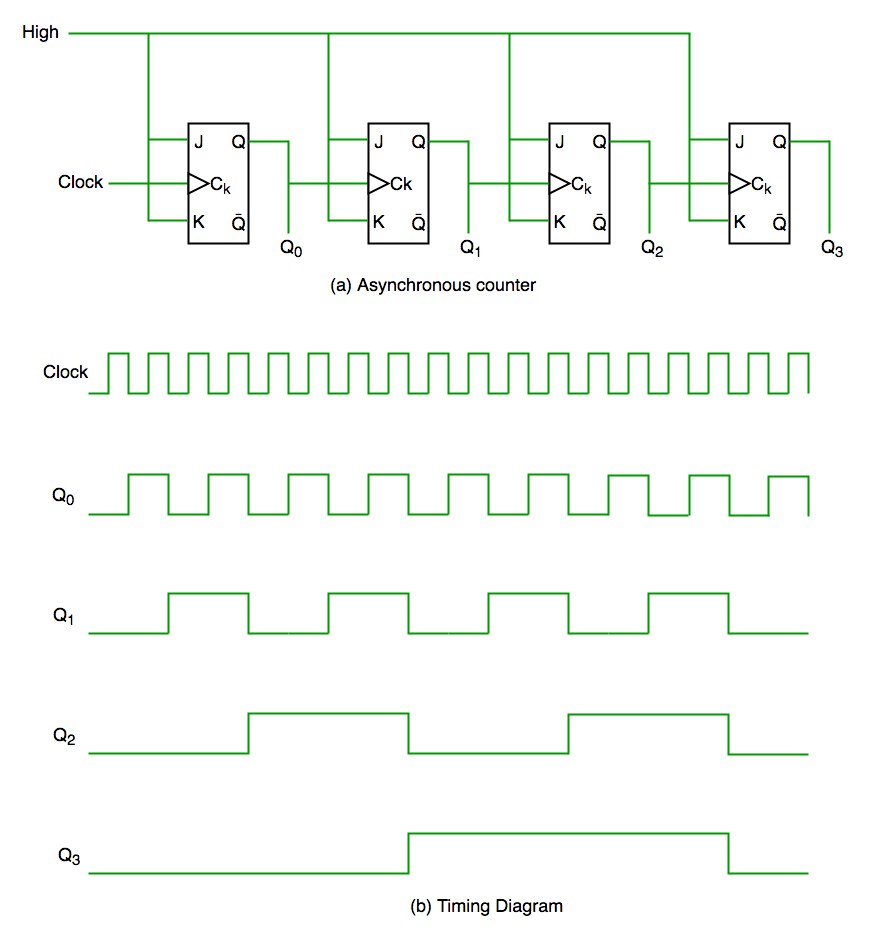COUNTERS
Counter is a sequential circuit. A digital circuit which is used for a counting pulses is known counter. Counter is the widest application of flip-flops. It is a group of flip-flops with a clock signal applied.
According to Wikipedia, in digital logic and computing, a Counter is a device which stores (and sometimes displays) the number of times a particular event or process has occurred, often in relationship to a clock signal. Counters are used in digital electronics for counting purpose, they can count specific event happening in the circuit. For example, in UP counter a counter increases count for every rising edge of clock. Not only counting, a counter can follow the certain sequence based on our design like any random sequence 0,1,3,2… .They can also be designed with the help of flip flops.
Counters are of two types.
- Asynchronous or ripple counters.
- Synchronous counters.
Asynchronous Counter
. Synchronous Counter
Unlike the asynchronous counter, synchronous counter has one global clock which drives each flip flop so output changes in parallel. The one advantage of synchronous counter over asynchronous counter is, it can operate on higher frequency than asynchronous counter as it does not have cumulative delay because of same clock is given to each flip flop.
Synchronous counter circuit
Timing diagram synchronous counter
Some previous years gate questions on Counters
Q1. Consider the partial implementation of a 2-bitt counter using T flip-flops following the sequence 0-2-3-1-0, as shown below
To complete the circuit, the input X should be
(A) Q2′
(B) Q2 + Q1
(C) (Q1 ⊕ Q2)’
(D) Q1 ⊕ Q2 (GATE-CS-2004)
(B) Q2 + Q1
(C) (Q1 ⊕ Q2)’
(D) Q1 ⊕ Q2 (GATE-CS-2004)
Solution:
From circuit we see
T1=XQ1’+X’Q1—-(1)
AND
T2=(Q2 ⊕ Q1)’—-(2)
AND DESIRED OUTPUT IS 00->10->11->01->00
SO X SHOULD BE Q1Q2’+Q1’Q2 SATISFYING 1 AND 2.
SO ANS IS (D) PART.
Differences between Synchronous and Asynchronous Counter
Counters are of two types depending upon clock pulse applied. These counters are: Asynchronous counter, and Synchronous counter.
In Asynchronous Counter is also known as Ripple Counter, different flip flops are triggered with different clock, not simultaneously. While in Synchronous Counter, all flip flops are triggered with same clock simultaneously and Synchronous Counter is faster than asynchronous counter in operation
In Asynchronous Counter is also known as Ripple Counter, different flip flops are triggered with different clock, not simultaneously. While in Synchronous Counter, all flip flops are triggered with same clock simultaneously and Synchronous Counter is faster than asynchronous counter in operation
| S.NO | SYNCHRONOUS COUNTER | ASYNCHRONOUS COUNTER |
|---|---|---|
| 1. | In synchronous counter, all flip flops are triggered with same clock simultaneously. | In asynchronous counter, different flip flops are triggered with different clock, not simultaneously. |
| 2. | Synchronous Counter is faster than asynchronous counter in operation. | Asynchronous Counter is slower than synchronous counter in operation. |
| 3. | Synchronous Counter does not produce any decoding errors. | Asynchronous Counter produces decoding error. |
| 4. | Synchronous Counter is also called Parallel Counter. | Asynchronous Counter is also called Serial Counter. |
| 5. | Synchronous Counter designing as well implementation are complex due to increasing the number of states. | Asynchronous Counter designing as well as implementation is very easy. |
| 6. | Synchronous Counter will operate in any desired count sequence. | Asynchronous Counter will operate only in fixed count sequence (UP/DOWN). |
| 7. | Synchronous Counter examples are: Ring counter, Johnson counter. | Asynchronous Counter examples are: Ripple UP counter, Ripple DOWN counter. |






No comments:
Post a Comment